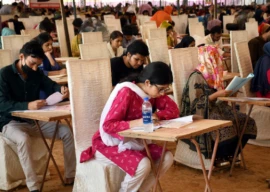He is an Imran Khan fan, and longs to play cricket, but knows that he cannot play the game.
“He’s got a fever”, Munni says, wiping her eyes as they well-up, insisting the tears are due to smouldering coals heating the iron.
The disease that struck Munni’s family though, has now been banished from India – at least for the time being.
On January 13, 2012, India reached a major milestone in its history of polio eradication – a 12-month period without any case of polio being recorded – an endorsement of the effectiveness of the country’s polio eradication strategies and their implementation.
Polio Ravivar (Sundays) used to be a nuisance. Just as the family was sitting down to a Sunday lunch, the doorbell would ring.
On Saturday, India was taken off a list of polio endemic countries by the World Health Organisation.
“Any child in the household, five years old or below,” young boys would ask in a chorus. If there was a child in the house, drops of the polio vaccine would be forced down their throat, whether they liked it or not.
The vigilance, despite its nuisance value, appears to have paid off and has driven the disease, for long a dreaded scourge, out of India.
During each National Immunisation Day, nearly 2.3 million volunteers, under the direction of 155,000 supervisors, visited 209 million homes across the country to administer the Oral Polio Vaccine (OPV) to around 172 million children under the age of five.
When the country was on the move, the campaign went along. Mobile vaccination teams administered the vaccine at railway stations, inside running trains, at bus stands, market places and construction sites. Around five million children were immunised by transit and mobile teams during every round in Uttar Pradesh, Bihar and Mumbai alone.
Persistence of the virus, despite rapid economic growth especially in the last decade, was a sore point for the Indian government. The country was bracketed with Afghanistan, Nigeria and Pakistan – the only three countries where polio remains as of January 2012.
Volunteers engaged in the task of administering the vaccine had to act as counsellors and myth-busters as well as mobile doctors: they had to assure mothers that the polio vaccine does not cause impotence, cast an evil eye on the child, or prevent the child from growing.
The result: two polio-fraught states of Uttar Pradesh and Bihar have not reported any case of polio since April 2010 and September 2010, respectively. The transmission of the most dangerous strain, wild poliovirus type 1, which caused 95% of polio cases in India until 2006, dropped to record low levels in 2010.
The key challenge now is to ensure any residual or imported virus in the country is rapidly detected and eliminated. This requires very high levels of vigilance and emergency preparedness. The importation of wild poliovirus into China in 2011 highlights the risk that India faces of polio returning to the country.
It might be too late for Munni’s son – but other children can sleep safer for now.
Published in The Express Tribune, February 26th, 2012.
COMMENTS (3)
Comments are moderated and generally will be posted if they are on-topic and not abusive.
For more information, please see our Comments FAQ

1726117332-0/Megan-Thee-Stallion-(1)1726117332-0-165x106.webp)





















@whoever: Probably meant Imran Khan the young Bollywood actor?
@ Editor...
How come a 10 yr old become a fan of Imran khan . I am 25+ , I have never seen Imran Khan playing international cricket as i was 5 or 6 at that time . How come this 10 yr old guy watched Imran's show and became a fan ?? If we assume he was watching reviews of cricket , then how couldn't he see the polio advertisement which was being shown in the interval of every 10 mins ? I won't feel sorry for this kind of parents.....